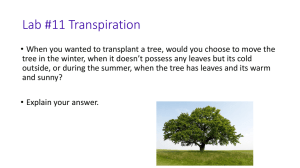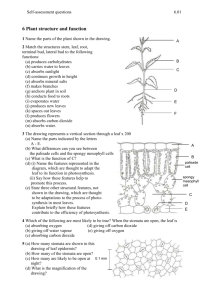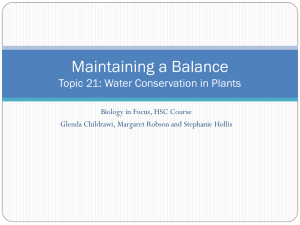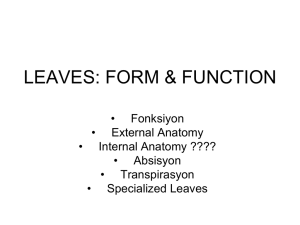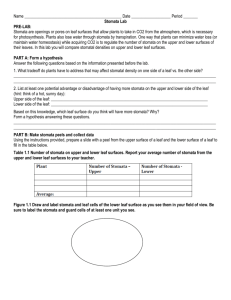Plants Leaves
advertisement
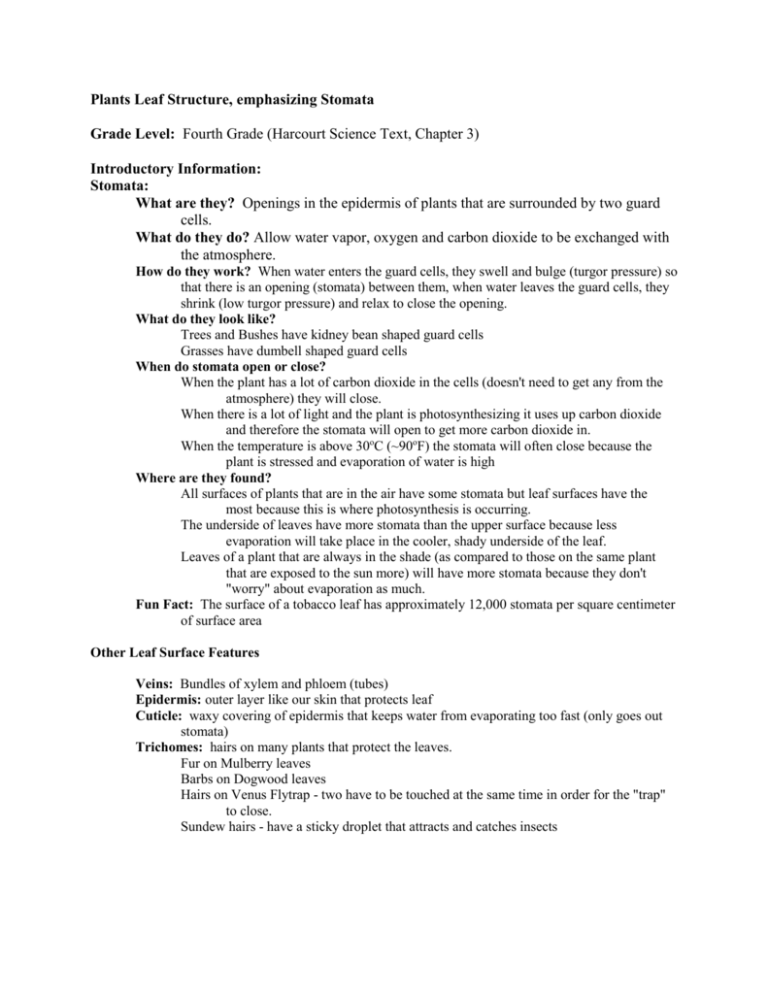
Plants Leaf Structure, emphasizing Stomata Grade Level: Fourth Grade (Harcourt Science Text, Chapter 3) Introductory Information: Stomata: What are they? Openings in the epidermis of plants that are surrounded by two guard cells. What do they do? Allow water vapor, oxygen and carbon dioxide to be exchanged with the atmosphere. How do they work? When water enters the guard cells, they swell and bulge (turgor pressure) so that there is an opening (stomata) between them, when water leaves the guard cells, they shrink (low turgor pressure) and relax to close the opening. What do they look like? Trees and Bushes have kidney bean shaped guard cells Grasses have dumbell shaped guard cells When do stomata open or close? When the plant has a lot of carbon dioxide in the cells (doesn't need to get any from the atmosphere) they will close. When there is a lot of light and the plant is photosynthesizing it uses up carbon dioxide and therefore the stomata will open to get more carbon dioxide in. When the temperature is above 30oC (~90oF) the stomata will often close because the plant is stressed and evaporation of water is high Where are they found? All surfaces of plants that are in the air have some stomata but leaf surfaces have the most because this is where photosynthesis is occurring. The underside of leaves have more stomata than the upper surface because less evaporation will take place in the cooler, shady underside of the leaf. Leaves of a plant that are always in the shade (as compared to those on the same plant that are exposed to the sun more) will have more stomata because they don't "worry" about evaporation as much. Fun Fact: The surface of a tobacco leaf has approximately 12,000 stomata per square centimeter of surface area Other Leaf Surface Features Veins: Bundles of xylem and phloem (tubes) Epidermis: outer layer like our skin that protects leaf Cuticle: waxy covering of epidermis that keeps water from evaporating too fast (only goes out stomata) Trichomes: hairs on many plants that protect the leaves. Fur on Mulberry leaves Barbs on Dogwood leaves Hairs on Venus Flytrap - two have to be touched at the same time in order for the "trap" to close. Sundew hairs - have a sticky droplet that attracts and catches insects Observing Stomata Activity 1: modeling the form and function of stomata Materials Needed: 2 elongate balloons 2 straws masking tape rubber cement clay or play-do Procedure: 1. Insert a straw into the opening for each balloon and seal using masking tape. 2. Fill the 2 balloons with air, approximately 50% full, plug straws with clay so that no air escapes. 3. Using the rubber cement, attach the 2 balloons together at both ends (should look like a flat donut). 4. Spiral wrap masking tape around each balloon (should look like barber poles). You now have a model of a closed stomata. 5. Unplug the straws and inflate the balloons fully, the ends should remain attached but the middles should move apart. You now have a model of an open stomata. 6. This activity should be done after it has been explained that stomata open and close with a change in the turgor pressure inside the guard cells (more water/air, higher turgor pressure, open stomata). Activity 2: Observing actual leaf stomata Materials needed: Various leaves freshly collected from live plants (holly, monkey grass, and Japanese magnolia work well). Super Glue Glass Slides Paper towels Procedure: 1. Make wet mounts of small, thin pieces of leaves (place leaf piece on slide, add 1-2 drops of water, cover with a cover slip); using a compound microscope with transmitted light, observe stomata (the thicker the leaf, the more light needed, top light will also work), a magnification of 200-400x should be sufficient ** Leaves may be too thick or the light not strong enough to see stomata To make impressions of the leaf surface and stomata 1. Clean glass slide and then place one small drop of super glue on slide 2. Allow drop to set for no more than 30 seconds 3. Press the underside of a leaf into the drop of super glue (use a paper towel to keep off fingers), apply pressure for 30 to 60 seconds (30 seconds for thin leaves, 60 seconds for thick leaves) 4. Remove pressure but let leaf remain on slide for 15 seconds. 5. Carefully peel leaf from slide, leaving super glue on slide, allow to dry for 10 minutes. 6. Observe impression on compound microscope to see stomata and other surface features. **This activity can be done as a class project for older students. The instructor should try it ahead of time to work out the details of timing for their super glue and plant species. It can be done as a demonstration for younger students. Leaf Pigment Information and Activities on the Web: http://www.sciencemadesimple.com/leaves.htm http://www.esf.edu/pubprog/brocure/leaves/leaves.htm


